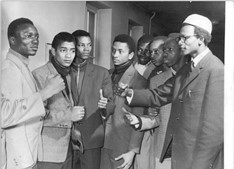‘Against Nuclear Imperialism’: peace, race and anti-colonialism in the early 1960s
In the late 1950s and early 1960s, campaigns against nuclear weapons and racism overlapped in powerful ways. On the surface – and in public perception – movements for peace and nuclear disarmament seem largely Eurocentric, their leaders and followers largely white. But peace was a significant thread in Black politics, too. In territories such as Ghana and South Africa, passive resistance was part of the tactical arsenal of anti-colonial movements in the 1950s. And even though liberation movements turned to militancy, violence and insurgency, in southern Africa, in south-east Asia and in Latin America during the 1960s, Black activists were far from invisible in the peace movement.
Key African American activists lived lives which entangled peace, passive resistance, anti-colonialism and civil rights. One prominent voice of African solidarity was Bill Sutherland, who travelled to west Africa in the early 1950s and remained for decades working in Ghana and Tanzania to promote training centres for Gandhian passive resistance. Another was Bayard Rustin, a key organiser in the US Civil Rights movement, whose life as an activist began with conscientious objection to conscription during the second world war. In the late 1950s and early 1960s, Rustin was himself drawn to Africa to participate in campaigns against the French atom bomb tests in the Sahara and in support of nationalist movements in Zambia.
Nor were African voices absent in international efforts to initiate state-level moves towards disarmament. In parallel with its commitments to the Non-Aligned Movement, the government of Ghana sponsored a series of anti-nuclear conferences in the early 1960s, culminating in the 1962 Accra Assembly on ‘The World Without the Bomb’. After the conference a small organisation was established in Ghana headed by a government official, Frank Boaten, to continue its efforts at disarmament. Alongside these official initiatives, small nuclear disarmament campaigns were set up by activists in countries including Sierra Leone and South Africa.
The cause of nuclear disarmament never supplanted, and was invariably entangled with, the critical political questions of racial discrimination and liberation. Even Boaten, who invested enormous energy in efforts to promote the ‘denuclearisation of Africa’, tied the reduction of military spending to ‘saving resources for [economic] development’. But ‘nuclear imperialism’ did, as the image of African students in the German Democratic Republic in 1960 demonstrates, nevertheless mobilise Black activism. In 1963, the annual Aldermaston CND march in the UK included national delegations from forty African and Asian states. Peace, anti-colonialism and international solidarity were – even for a brief moment – a powerful combination.
by Rob Skinner
References
Allman, Jean. ‘Nuclear Imperialism and the Pan-African Struggle for Peace and Freedom: Ghana, 1959–1962’. Souls 10, no. 2 (2008): 83–102.
Sutherland, Bill, Guns and Gandhi in Africa: Pan African Insights on Nonviolence, Armed Struggle and Liberation in Africa. Trenton, N.J.: Africa World Press, 2000.
Wittner, Lawrence S. Resisting the Bomb: A History of the World Nuclear Disarmament Movement 1954-1970. Stanford, Calif.: Stanford University Press, 1997.

